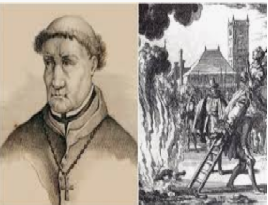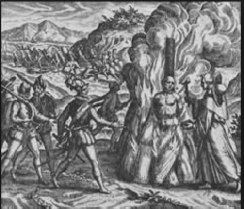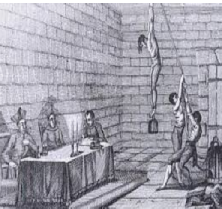|
PART 1 T O P I C |
|
|
|
|
|
|
|
|
|
|
|
|
|
|
|
|
|
|
|
CLICK BUTTON |
|
|
|
|
|
|
|
|
|
|
|
|
|
THE INQUISITION AND THE |
|
|
|
|
JewishWikipedia.info
ARCHIVE OF THE INQUISITION
Geni
The Archive of the Inquisition (or more fully the Archive of the Inquisition and Index), officially referred to as the Archive of the Congregation for the Doctrine of the Faith (abbreviated to ACDF for Archivio Congregatio pro Doctrina Fidei) in the Vatican, contains the Catholic Church's documents dealing with doctrinal and theological issues related to church teaching. It also contains information on political trials that were carried out when the papacy had temporal power over the Papal States.
BACKGROUND
By 1500, the Catholic Church had reached an apparently dominant position as the established religious authority in western and central Europe dominating a faith-landscape in which Judaism, Waldensianism, Hussitism, Lollardry and the finally conquered Muslims al-Andalus (the Muslim-dominated Spain) hardly figured in terms of numbers or influence.
When the institutions of the Church felt themselves threatened by what they perceived as the heresy, and then schism of the Protestant Reformation, they reacted.
Paul III (Pope from 1534 to 1549) established a system of tribunals, administered by the "Supreme Sacred Congregation of the Universal Inquisition", and staffed by cardinals and other Church officials. This system would later become known as the Roman Inquisition.
In 1908 Pope Saint Pius X renamed the organisation: it became the "Supreme Sacred Congregation of the Holy Office". This in its turn became the "Congregation for the Doctrine of the Faith" in 1965, which name continues to this day.
OPENING
On 22 January 1998 the Vatican opened all Inquisition archives up to the death of Leo XIII. At first, there was space for only twelve scholars within the archives, but this has been increased as demand for the use of the material has increased.
CONTENTS
Among the episodes in Inquisition history are the tens of thousands of trials in which accused individuals or reos faced questioning, sometimes torture, and ultimately sentencing (when found guilty) at the hands of inquisitional functionaries.
- The notorious policies of secrecy combined with equally notorious outcomes inspired huge levels of fear.
- These documents provided researchers with crucial evidence regarding the Inquisitors actual exercise of power and their impact on targeted segments of society.
- More or less complete trial transcripts show the spectacular cases of Archbishop Carranza (1559-1576).
LIST OF THOSE TRIED
Below is a list of people found in the Archive of the Inquisition that have profiles on Geni.
Antonia Roiz o Maduro -
sentenced to be burned to death by the Inquisition in Portugal for "crimes against the Catholic faith and for observance of the laws of Moses." He was burned alive at the stake in the central square of the Portuguese city of Coimbra.
António José da Silva, o judeu (1705-1739)
Branca Dias (1515-1558)
Cardinal Morone (1552-1559)
Gallileo Galilei (1633)
Luis de Carvajal and his family (1589-1596) –
Mexican crypto-Jew and his family
Dona Gracia Mendes Nasi -
a 16th century international banker who created an escape network that saved thousands of Crypto-Jews from the Inquisition. She was also a patron of (Jewish) writers, and a diplomat on behalf of her people, who also attempted to start a modern state of Israel.
Luis Carvajal de la Cueva – (1537-1580)
the governor of the state of Nuevo León, a northern Mexico province in which the restriction against immigration from conversos was relaxed in order to encourage migration to the peril-fraught frontier. He was responsible for bringing a significant group of crypto-Jewish conversos living in Portugal since the Expulsion of 1492.
Felix de Miranda -
a New Christian business man, native of the town of Almeyda in the Bishopric of Lamego, convicted and burned at the stake.
Luis de Carvajal el Mozo -
the nephew of Jose Luis Carvajal y de la Cueva, the only crypto-Jew of the Spanish colonial era whose memoirs have been preserved.
Antonio Fernandez Carvajal -
a Portuguese merchant in London; "like other Marranos in London, Carvajal prayed at the Catholic chapel of the Spanish ambassador, while simultaneously playing a leading role in the secret Jewish community, which met at the clandestine synagogue at Creechurch Lane." Some scholars of Judaic studies believe that Miguel de Cervantes may have been a crypto-Jew or of crypto-Jewish descent.
Rodrigo Lopez -
a converso who fled from Portugal to England and became physician to
Queen Elizabeth I.
Giordano Bruno -
burned alive at the stake on piazza Campo de’ Fiori, in Rome, on February 17, 1600, for his convictions, which were judged heretical by the Tribunal of the Roman Inquisition, the Vatican Secret Archives unveils the summary of the trial of Giordano Bruno, the 17th document on display at the Capitoline Museums in the Lux in Arcana: The Vatican Secret Archives Reveals Itself exhibition.
Tomas Trebino de Sobremonte,
a very wealthy and influential Converso, was imprisoned for 5 years, beaten and tortured daily, and was forced to watch as his wife and children were dismembered before his eyes. He was finally burned alive at the stake by the Spanish Inquisition on April 11, 1649, in Guaxaca, Virreinato de Nueva España.
Mateus Lopes Franco (1600-1657)
Luis Lopes Franco (1600-16??)
INTRODUCTION TO INQUISITION TRIAL
TRANSCRIPTS AND RECORDS
University of Notre Dame
TRIAL TRANSCRIPTS
Among the most fascinating and disquieting episodes in inquisition history are the tens of thousands of trials in which accused individuals or reos faced questioning, sometimes torture, and ultimately sentencing (when found guilty) at the hands of inquisitorial functionaries. Such exercises in the judgment of heretical behavior were after all the inquisitors’ raison d’être, and their notorious policies of secrecy combined with equally notorious outcomes to inspire fear and fantasy from medieval times right up to the present day. Defendants ranged from the extremely high profile to complete unknowns, and the resulting wide diversity of cases generated an extremely diverse documentary record across tribunals and through the centuries. Given the sheer number of recorded trials, and their often ad hoc manner of transcription and preservation, research in this area is frequently a hit-or-miss affair. Nevertheless, scholars have devoted more attention to analysis of trial records than to any other inquisitorial source. Whether in close readings of individual trials, or in deriving qualitative and/or quantitative data from whole (sometimes quite enormous) series of proceedings, these documents provide modern researchers with crucial evidence regarding the inquisitions’ actual exercise of power and their impact on targeted segments of society. Given the levels of detail that can emerge from the more extensive testimonial records, these sources have also proved valuable to social, religious and intellectual historians with an interest in the everyday lives and beliefs of deponents—quite apart from their status as collaborators with or victims of the inquisition per se.
Trial documents can also be more than just sites from which information on the ways, means and subjects of persecution are mined. They constitute a distinct genre of their own, and the different forms in which inquisitorial staff chose to represent and record trial events reveal much about the changing nature of their institution. Whatever a researcher’s focus, it is important to recognize the different types of document for what they are. The following admittedly partial and tentative overview of documents relating to inquisitorial trials and sentencing is intended to draw attention to some of the variations that can be encountered in library or archival holdings; some are relatively well known but others have traditionally been under-utilized. It is to be hoped that future generations of scholars will find gain new insights from both the former and the latter.
In theory, all stages of a formal trial by inquisition should have been diligently recorded and carefully archived for future reference.3 Countless folios of parchment and paper were undoubtedly filled by scribes from the very earliest days of inquisitorial activity; yet few early exemplars have survived. Medieval inquisition trial records can now be identified for a small number of cases; many of their surviving number have been edited and some have been translated in whole or in part, and so are relatively accessible. They range for example from short individual interrogations such as were conducted among the Albigensian communities of southern France, to more politically sensitive and hence substantial trials of leading figures such as Joan of Arc and her comrade-in-arms Gilles de Rais.
The same sort of variety can also be found in the more numerous surviving records of early modern Spanish, Portuguese, Roman, and New World inquisition tribunals. More or less complete trial transcripts have been identified, published and studied at length in many instances: the spectacular cases of archbishop Carranza (1559-1576), cardinal Morone (1552-1559) or Galileo Galilei (1633) are well known, but even those of lesser figures such as the Mexican crypto-Jew Luis de Carvajal and his family (1589-1596) have found their audience. Countless equally interesting cases remain unpublished and wholly unstudied, as for example the Notre Dame collection’s lengthy trial of Mexican muleteer Gaspar de los Reyes and his mestiza companion Catelina de Parraga, 1620-1622 [INQ 119].6
Many trials, for a variety of reasons, generated less extensive and hence less informative transcriptions, a fact which can be challenging to interpret. Some, written in haste and subsequently ill-treated, have come down to us in fragmentary notes [INQ 117] or barely legible tatters [INQ 586]; their historical importance remains nonetheless.7 Others were more carefully preserved but lack essential components. Such is the case with a 1774 Mexican inquest alleging sorcery and demonic possession committed by a nomadic healer known as “San Juana” and her daughter Viviana [INQ 123]. After two years of enquiry and expert testimony neither of the accused could be located for questioning, so we lack the crucial “defense” side of the story; their case, replete with intriguing details for social historians, was dismissed for lack of evidence. Even if the curanderas could have been made to testify, too, their recorded words would inevitably suffer distortions. The notaries’ objective to “write down everything that the inquisitor or inquisitors say to the prisoner, and what the prisoner says in return” could seldom be achieved in reality.8 Whatever sort of dialect the Mexican Indian Atanacio de la Cruz may have utilized in arguing his own defense, for example, the record of his 1799 trial for allegedly making a pact with the Devil consists of highly abbreviated summaries and paraphrases set down in the notary’s familiar Spanish idiom [INQ 125].9
Transcripts also tended to go through various stages of drafting, and archived versions can vary widely from collections of rough notes and original letters to polished (and perhaps heavily edited) final copies. Often the extant dossiers are composite mixtures of documents recorded on different occasions and by different scribes; witness testimony alternates with notarial documents inserted to record events such as arrests, transfers, torture, deliberations and judgments. The trial of a Franciscan priest for a controversial 1766 sermon delivered in Mexico [INQ 121], for example, contains at least thirteen separate documents in different hands, including letters written by the defendant himself. The above-mentioned trial of Atanacio de la Cruz is similar in its complexity but also typical in that most of its once-separate original documents were gathered together and registered seriatim in more-or-less chronological order by a single copyist. By taking these details of composition and record-keeping into account, researchers can gain a more nuanced understanding of the actual circumstances in which their primary source data were generated. Inquisitorial trials were not always the models of cold bureaucratic efficiency depicted in polemical imagery [INQ 550].
Click here to access the following detail
PARTIAL TRIAL RECORDS
OTHER TYPES OF TRIAL AND SENTENCING RECORDS
APPENDIX: INVENTORY OF TRIALS AND SENTENCING SOURCES AT NOTRE DAME
THE TRANSFER AND RETURN OF THE
VATICAN SECRET ARCHIVES TO PARIS
Vatican
In February 1810, Napoleon decided that all the documentation preserved in the archives were transferred to Rheims, but then the destination became Paris. Various convoys - made up of enormous wagons carried about 3.239 cases (or chests) of documents coming from the archives of the Holy See, including (or better in primis) the Vatican Secret Archives - left Rome and headed for Paris in the month of February of that same year; other similar transfers followed.
In Paris, the great number of precious papers were placed in Soubise Palace and from there they were supposed to go to the planned Central Archives of the Empire, that were being built on the Drill Ground; but were never accomplished because of the rapid fall of Napoleon.
After the fall of Napoleon (11th April 1814), King Louis XVIII, of the restored Bourbon Dynasty, decided to return the Vatican Archives to the Pope, so the Pope sent some of his trustworthy men to Paris,
On 28th April 1814 in Paris, the Vatican archives at Soubise Palace were publicly handed over. These operations were suddenly interrupted by the Napoleonic period of the Hundred Days (26th February – 22nd June 1815); in this lapse of time the provisions to return the archives to the Pope were declined, the Vatican archivists were thrown out of Paris and the documents were seriously damaged and tampered.
When Napoleon was defeated on the 12th August Pius VII preparation for the transfer of the archives back to the Vatican resumed and the first wagons left in October, by sending back the documents Rome most urgently felt the need to have. Even on their way back to Rome, entire wagons of documents were lost because of accidents (in Piedmont, for instance, some wagons nearly lost their entire precious load while crossing the River Taro).
On 23rd December 1815 the first part of the documentation taken away by Napoleon was handed over to the Pope instructions were given for archives still found on French soil to be returned to Rome. The enormous transport costs obliged the Secretariat of State to issue orders to the delegates to save money, so it was decided that «useless papers, that could be burnt» were to be destroyed directly on the spot so hundreds (if not thousands) of pieces were burnt and thousands of others sold to be used as wrapping paper by the Parisian delicatessen shopkeepers. Therefore, many series of Vatican archives were mutilated and others were totally lost. Between July 1816 and March 1817, several trains of wagons headed for Rome and the Vatican material gradually returned to the Holy See (with the above-mentioned losses) in the years that followed.
The disorder with which the cases were prepared for the delivery of the documents, upon their arrival in the Vatican, some series of different archives of the Curia were confused with others and were therefore put in places that were absolutely inconsistent (for instance, some parts of the Holy Office went to the Vatican Library and to the Vatican Secret Archives; on the contrary, some documents of the Vatican Archives ended up in the Vatican Library or elsewhere). Throughout the years, these illogical displacements have been put into order and some series, at least virtually (on the indexes) have been reassembled. However, the wounds inflicted to the corpus of the Vatican archives by the inauspicious transfer to Paris, are still clearly evident.
(Note: A large number of documents passed through English hands ending in 1854 in the library of Trinity College, Dublin)
In 1834 the archives of the Spanish Inquisition became part of the National Archives of Spain. Being accessible they have been subject to more detailed analysis than have the Roman archives.
Inquisition and other early Hispanic Archives
Inquisition archives worldwide University of Notre Dame
Archive of the Congregation for the Doctrine of the Faith (Vatican Archive) Wikipedia
THE
INCREDIBLE
STORY OF THE JEWISH PEOPLE
|
The Transfer |
The Transfer |



INQUISITION RECORDS AND ARCHIVES
